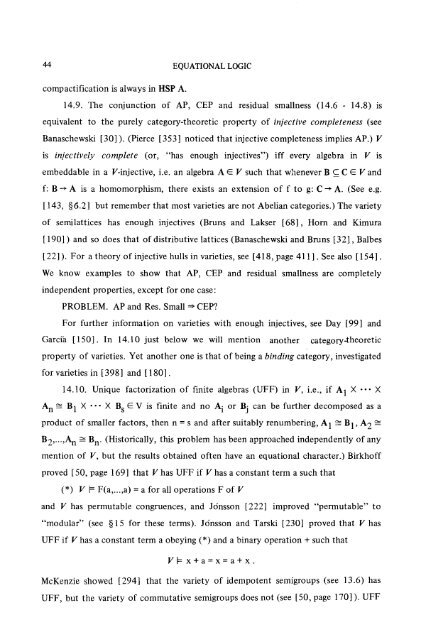Survey 1979: Equational Logic - Department of Mathematics ...
Survey 1979: Equational Logic - Department of Mathematics ...
Survey 1979: Equational Logic - Department of Mathematics ...
Create successful ePaper yourself
Turn your PDF publications into a flip-book with our unique Google optimized e-Paper software.
44 EQUATIONAL LOGIC<br />
compactification is always in HSP A.<br />
14.9. The conjunction <strong>of</strong> AP, CEP and residual smallness (14.6 - 14.8) is<br />
equivalent to the purely category-theoretic property <strong>of</strong> injectire completeness (see<br />
Banaschewski [30] ). (Pierce [353] noticed that injective completeness implies AP.) V<br />
is injectively complete (or, "has enough injectives") iff every algebra in V is<br />
embeddable in a V-injective, i.e. an algebra A C V such that whenever B C_ C C V and<br />
f: B A is a homomorphism, there exists an extension <strong>of</strong> f to g: C A. (See e.g.<br />
[ 143, õ6.2] but remember that most varieties are not Abelian categories.) The variety<br />
<strong>of</strong> semilattices has enough injectives (Bruns and Lakser [68], Horn and Kimura<br />
[190] ) and so does that <strong>of</strong> distributive lattices (Banaschewski and Bruns [32], Balbes<br />
[22]). For a theory <strong>of</strong> injective hulls in varieties, see [418,page 411 ]. See also [154].<br />
We know examples to show that AP, CEP and residual smallness are completely<br />
independent properties, except for one case'<br />
PROBLEM. AP and Res. Small CEP?<br />
For further information on varieties with enough injectives, see Day [99] and<br />
Garcih [150]. In 14.10 just below we will mention another category-theoretic<br />
property <strong>of</strong> varieties. Yet another one is that <strong>of</strong> being a binding category, investigated<br />
for varieties in [398] and [ 180].<br />
14.10. Unique factorization <strong>of</strong> finite algebras (UFF) in V, i.e., if A 1 X -.. X<br />
A n- B 1 X --. X B s V is finite and no A i or Bj can be further decomposed as a<br />
product <strong>of</strong> smaller factors, then n = s and after suitably tenumbering, A 1 - B1, A 2<br />
B 2 ..... A n - B n. (Historically, this problem has been approached independently <strong>of</strong> any<br />
mention <strong>of</strong> V, but the results obtained <strong>of</strong>ten have an equational character.) Birkh<strong>of</strong>f<br />
proved [ 50, page 169] that V has UFF if V has a constant term a such that<br />
(*) V F(a ..... a) = a for all operations F <strong>of</strong> V<br />
and V has permutable congruences, and Jdnsson [222] improved "permutable" to<br />
"modular" (see õ15 for these terms). Jdnsson and Tarski [230] proved that V has<br />
UFF if V has a constant term a obeying (*) and a binary operation + such that<br />
Vx+a=x=a+x.<br />
McKenzie showed [294] that the variety <strong>of</strong> idempotent semigroups (see 13.6) has<br />
UFF, but the variety <strong>of</strong> commutative semigroups does not (see [50, page 170]). UFF

















